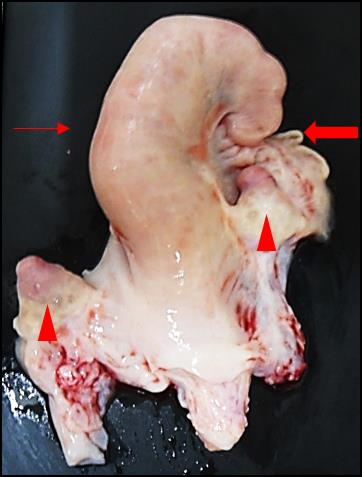Uterine segmental aplasia in sheep
DOI:
https://doi.org/10.21708/avb.2021.15.2.9376Abstract
The complete absence of one of the uterine horns, named segmental uterine aplasia or unicorn uterus, occurs due to deficiency in the development of segments of the paramesonephric or Mullerian ducts. It is a congenital or hereditary anomaly of the female reproductive tract caused by recessive genes, which occurrence is unusual. In cows, this malformation was initially called “white heifer disease”, comprising an alteration in the Mullerian ducts in association with the white skin gene that causes aplasia of the uterus, cervix and vagina. Two pieces of sheep reproductive system from a slaughterhouse under federal inspection in the state of Bahia, Brazil, were received for pathological diagnosis. The collection, dissection and macroscopic analysis were carried out. In the macroscopic evaluation, uterine segmental aplasia was identified in both cases, with complete absence of the left uterine horns. Both had agenesis of the uterine tubes associated with the absence of internal bifurcation of the uterine horns. Animals that have a unicorn uterus often have reduced fertility which consequently leads to losses to sheep farming.
Downloads

Downloads
Pubblicato
Fascicolo
Sezione
Licenza
Autores que publicam na Acta Veterinaria Brasilica concordam com os seguintes termos: a) Autores mantém os direitos autorais e concedem à revista o direito de primeira publicação, com o trabalho simultaneamente licenciado sob a Licença Creative Commons Attribution que permite o compartilhamento do trabalho com reconhecimento da autoria e publicação inicial nesta revista. b) Autores têm autorização para assumir contratos adicionais separadamente, para distribuição não-exclusiva da versão do trabalho publicada nesta revista (ex.: publicar em repositório institucional ou como capítulo de livro), com reconhecimento de autoria e publicação inicial nesta revista. c) Autores têm permissão e são estimulados a publicar e distribuir seu trabalho online (ex.: em repositórios institucionais ou na sua página pessoal) a qualquer ponto antes ou durante o processo editorial, já que isso pode gerar alterações produtivas, bem como aumentar o impacto e a citação do trabalho publicado (Veja O Efeito do Acesso Livre).


 Esta obra está licenciada com uma Licença
Esta obra está licenciada com uma Licença 